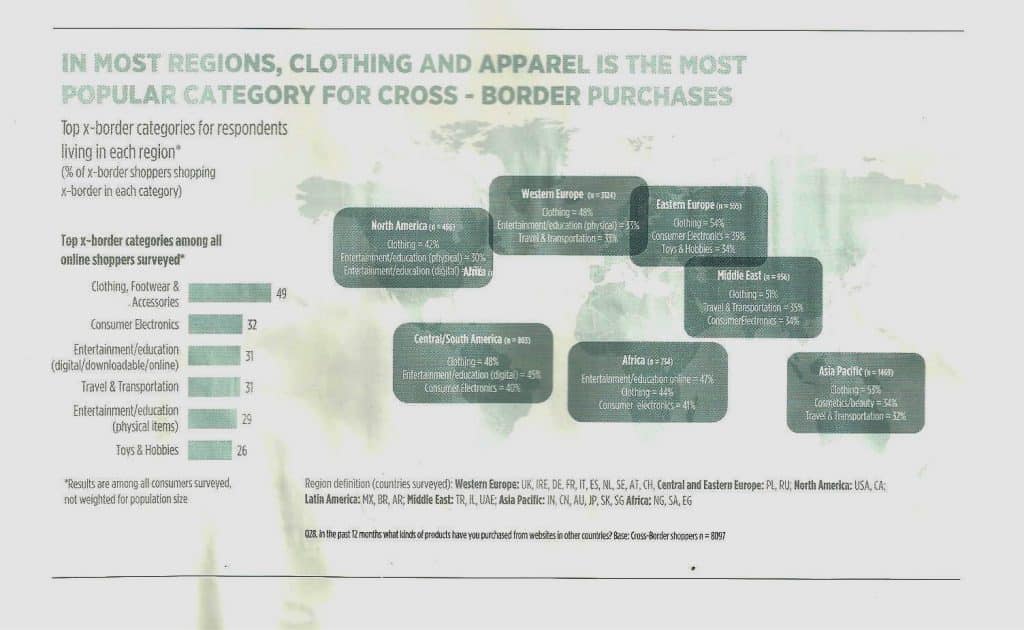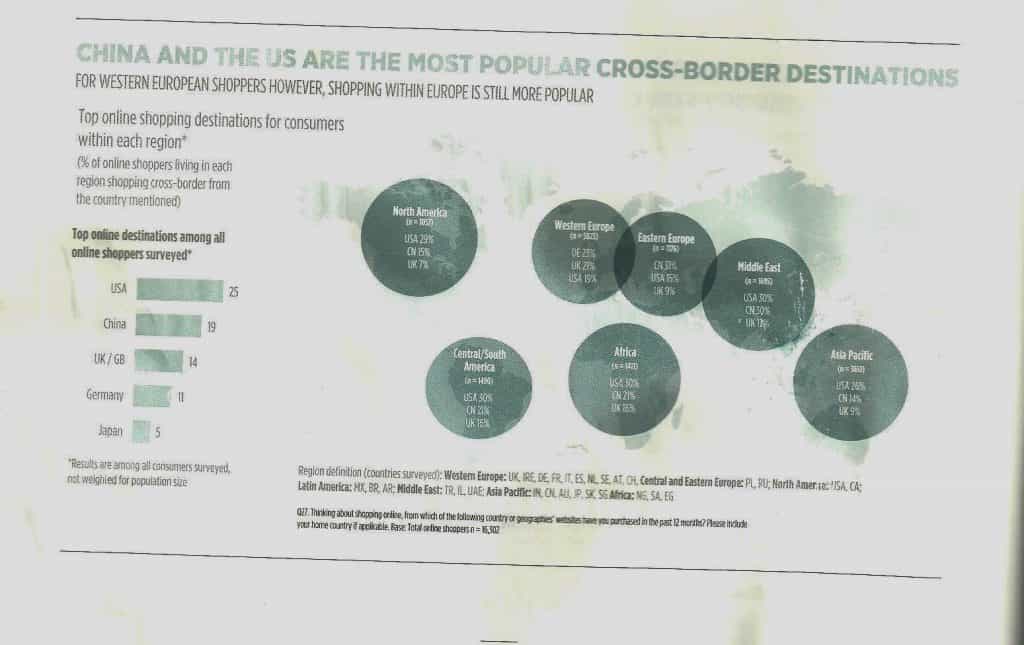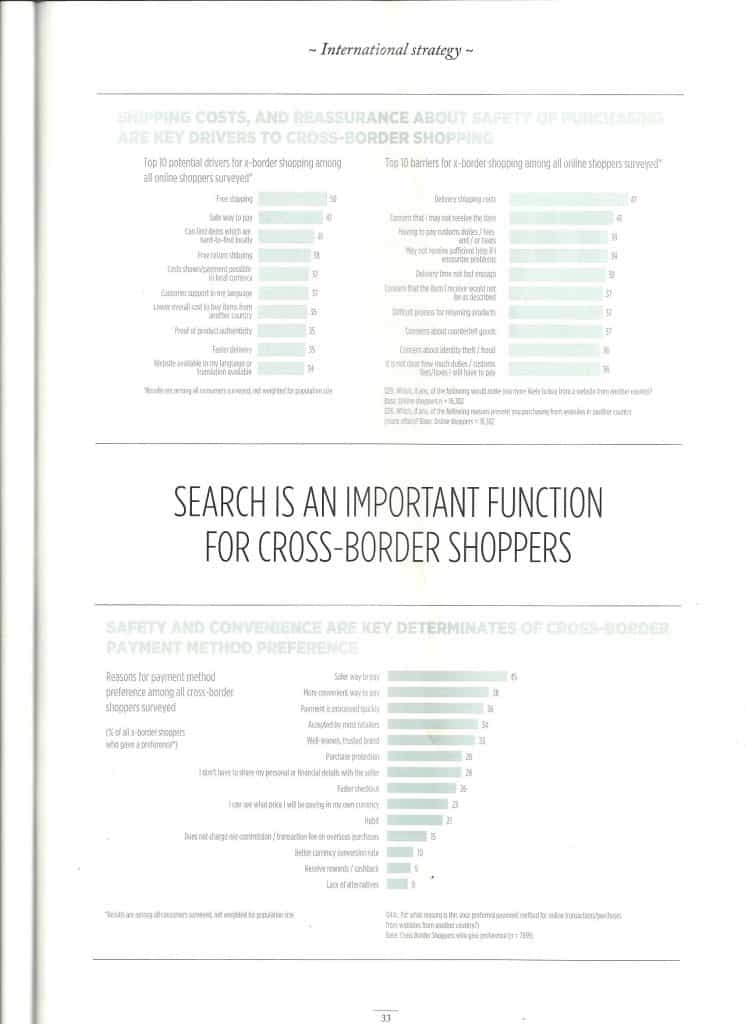
Cross-border e-commerce.
Companies that have decided to invest in a project e-commerce they understood that selling their products or services across borders is a winning strategy to reach new customers and increase the market. L'e-commerce it has amazing potential, but it is essential to keep in mind that, in order to exploit it, you need to plan a management strategy for the winning tool. If driven, a e-commerce it can help companies to expand their sales network across borders and, therefore, to have new sources of income abroad.
Recently, PayPal released his second annual world cross-border trade report, with the aim of making it easier for companies to better understand cross-border consumer behavior in key export markets.
The investigation, conducted by PayPal in partnership with Ipsos, analyzed the habits of Online shopping across the border to more than 23,000 consumers in 29 countries and revealed valuable insights into the how and why of the online trade, especially cross-border, is constantly evolving.
To understand if online businesses are on the right track, PayPal also commissioned the Ipsos research to understand the areas where European merchants see growth over the next 12 months and understand how their plans fit and accommodate online consumer behavior.
Western European companies mostly focus their business in EU countries, but is this enough?
The cross-border trade among the countries of the European Union it sees a dominance of the European digital single market. When European companies are asked what their plans are to expand the market in the coming months, they reveal that they look confidently at markets within the EU. Why don't Western European traders aspire to expand their business outside the EU borders?
For example, UK companies that trade online identify Asia as their third largest market by online sales across borders. However, following a survey of consumers in the 29 countries surveyed, it emerged that the highest demand for British products comes from Chinese consumers. Statistics show that 21.9 million online shoppers in China bought from UK retailers in 2015. Yet only 15% of UK online businesses surveyed report selling to Chinese customers. The imbalance between consumer demand and online market supply is evident.
For European traders who want to make the leap and sell their products or services even outside the EU, here are some valuable tips to win over consumers around the world:
- Free shipping;
- Website security, reliability and variety of payment options;
- Local language and currency addressing.
Where and why do consumers buy outside their national borders?
The interview showed that three quarters (73%) of consumers who do purchases beyond their national borders, he prefers to buy abroad because he claims to find better prices; 67% of consumers also states that for cross-border purchases, there is a richer item section than for online stores of your country; consumer 58% reveals, however, that international markets offer new and more interesting products.
The main destinations for online shopping for Western European consumers are the UK and Germany.
As it emerged from the interview that international consumers are looking for quality products but at a good market price, it appears that Western European traders are missing out on a valuable opportunity, considering that they offer an excellent range of product categories with a excellent value for money, which is exactly what online shoppers are looking for.
Tips for traders:
The survey also reported the main guides that facilitate shopping across the border.
Merchants who want to increase conversion rates should make sure their customers can:
- Choose between different shipping options in terms of cost and time. (Free shipping is expensive for merchants, but, it is the biggest conversion driver for international consumers.
- Read clearly the information regarding taxes and customs on the site.
- Visualize local currency: 24% of Western European consumers surveyed say paying in foreign currency is not a factor that makes them reluctant to make international purchases; this is not the case for consumers in Central and Eastern Europe, who, on the other hand, declare that paying in foreign currency is one of the 10 factors that prevent them from buying from international websites.
- Use the PayPal service: payment method that makes consumers safe, both in the purchase phase and in returning the products.
Which payment method do consumers prefer for international payments?
Security, convenience and ease of payment are key factors in encouraging consumers to make international purchases in complete tranquility. From the interviews it emerged that the payment method most used in 2015 for online purchases was PayPal. PayPal appears to be the most used payment method in most countries, in Western Europe it is used by as many as 71% of consumers.
Reassure consumers by clearly indicating the payment methods offered.
International furniture numbers: future or actuality?
Today it is not possible to talk about e-commerce without considering it shopping on mobile devices. While in Western Europe there is only 20% of cross-border transactions through mobile / tablet devices; in the Middle East and Africa there are higher percentages, respectively 28% and 41% of cross-border transactions takes place on smartphones and tablets.
Transport: shipments and returns.
The 32% of Western European consumers used transportation services or friends and families abroad to buy something from another country. This statistic reveals opportunities for merchants to provide better shipping options for them. The European Commission recently identified a discrepancy between international and domestic shipments and noted that it is five times more expensive to ship internationally within the EU than to ship to the same country.
The percentage of returns varies from country to country. The 15% of Western European respondents sent the purchase back, but the 38% of consumers argues that free returns are a key factor in online shopping. Offering free returns is an international conversion key.
Discovery: How Do Consumers Find Websites?
Research is an important function for cross-border shoppers and the result of the research is that the needs of merchants are to diversify their marketing and investment strategies into different channels, not just SEO and SEM strategies which are expensive. Word of mouth and sites that allow you to compare products are considered to be of high value.
The contents of this article were taken from the authoritative magazine Cross – Border Magazine.
Oleksandra Oberemok, Astrid Huijsson, Insights to building your international strategy, in Cross-Border Magazine, 1, edition 1, June 2016, p. 30, 31, 32, 33.













